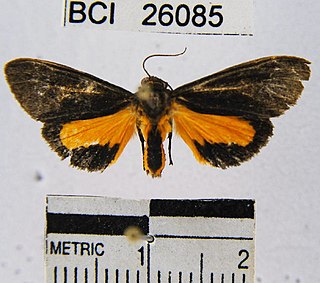
Ceryx is a genus of moths in the family Erebidae. It was described by Hans Daniel Johan Wallengren in 1863.

Lymantria is a genus of tussock moths in the family Erebidae. They are widely distributed throughout Europe, Japan, India, Sri Lanka, Myanmar, Java, and Celebes. The genus was erected by Jacob Hübner in 1819.

John Amplas is an American actor known primarily for his work with director George A. Romero, particularly his appearances in the title role of Martin (1978), as well as Dawn of the Dead (1978) and Creepshow (1982).

Virbia is a genus of tiger moths in the family Erebidae. The genus was erected by Francis Walker in 1854.

Autographa is a genus of moths of the family Noctuidae.

Autographa ampla, the large looper moth, raspberry looper, brown-patched looper or broken-banded Y, is a moth of the family Noctuidae. The species was first described by Francis Walker in 1858. It is found in North America from Newfoundland west to the Alaska panhandle, south to central California, Arizona and New Mexico in the west and North Carolina in the east.

Miscera is a genus of moths in the family Brachodidae.
Ceryx ampla is a moth of the subfamily Arctiinae. It was described by Francis Walker in 1864. It is found on Aru in Indonesia and Papua New Guinea.
Virbia brevilinea is a moth in the family Erebidae. It was described by Francis Walker in 1854. It is found in Brazil.
Virbia divisa is a moth in the family Erebidae. It was described by Francis Walker in 1854. It is found in Brazil.
Virbia dotata is a moth in the family Erebidae. It was described by Francis Walker in 1865. It is found in the Amazon region.
Virbia ferruginosa, the rusty holomelina, is a moth in the family Erebidae. It was described by Francis Walker in 1854. It is found from Nova Scotia to British Columbia in Canada. In the United States it is found from the northeast and upper Midwest, south to Virginia, Mississippi, Missouri and Louisiana.
Virbia luteilinea is a moth in the family Erebidae. It was described by Francis Walker in 1854. It is found in Mexico, Guatemala, Nicaragua, Panama and Colombia.

Virbia mentiens is a moth in the family Erebidae. It was described by Francis Walker in 1854. It is found in Venezuela and possibly Costa Rica.
Virbia subapicalis is a moth in the family Erebidae first described by Francis Walker in 1854. It is found in Brazil, Ecuador, Peru, Guyana, Suriname, Venezuela and Bolivia.
Sagalassa is a genus of moths in the family Brachodidae.

Ruspolia is a genus of bush crickets in the subfamily Conocephalinae. This genus includes species that may be called 'cone-heads', but the name has also been used for Conocephalus and other genera in the subfamily.

Lymantria ampla is a moth of the family Erebidae first described by Francis Walker in 1855. It is found in India and Sri Lanka.









